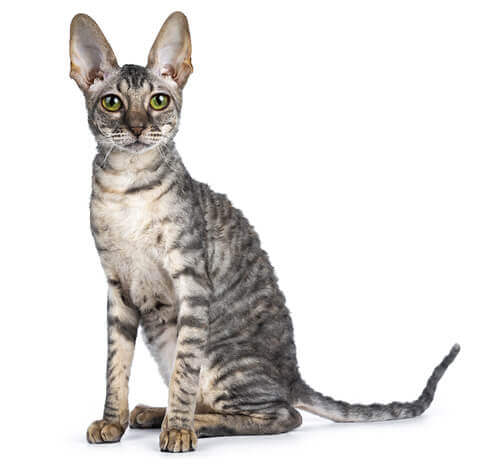
Bat-eared, big-eyed and wavy-coated, the Cornish Rex has a distinctive look and exceptionally silky coat due to not having guard hairs like other breeds. This active cat has a small, whippetlike body and loves to climb, leap and sprint. With kittenlike antics that last a lifetime, this feline likes to be where the action is. The Cornish Rex is perfect for those who want a cat to participate in their family life.
DID YOU KNOW? On July 21, 1950, in Cornwall, England, Nina Ennismore discovered that her domestic British Shorthair, a tortoiseshell-and-white cat named “Serena,” had given birth to a cream-colored male with tight rows of tiny curls that looked like a miniature lamb. Ennismore named the kitten “Kallibunker” and the breed Rex as it resembled the wavy fur of the Astrex rabbits she raised and exhibited.
The need-to-know
- Playful and curious cat
- Friendly but independent cat
- Somehow talkative cat
- Lean and elegant cat breed
- Requires grooming once a week
- Needs some out-door space
- May require familiarisation before living with children
Personality

Cornish Rex cats have a mischievous side to their character and a personality that can almost be described as forever young! Rexes are very intelligent, enjoy playing and love to learn new tricks. They will happily play fetching games for hours on end. While they are lively cats, they do have quieter times when they are happy to curl up in a lap. Cornish Rex cats can become cold quickly and will always seek out the warmest place to sleep.
History and Origins

Country of Origin: England (county of Cornwall)The Cornish Rex cat breed owes its existence to a natural mutation that was discovered in a kitten born to a farm cat in Cornwall in 1950 - it had a curly coat It was mated back to its mother and two of the resulting litter were born with the curly coats that are now associated with the breed. The Devon Rex cat and Cornish Rex cat breed curly hair mutations are different. Crossing Devon Rex cats and Cornish Rex cats produces litters of straight-coated kittens!
Nutrition and Feeding

Every cat is unique and each has their own particular likes, dislikes, and needs when it comes to food. However, cats are carnivores and every cat must obtain 41 different and specific nutrients from their food. The proportion of these nutrients will vary depending on age, lifestyle and overall health, so it's not surprising that a growing, energetic kitten needs a different balance of nutrients in her diet than a less active senior cat. Other considerations to bear in mind are feeding the right quantity of food to maintain 'ideal body condition' in accordance with feeding guidelines and catering to individual preference regarding wet or dry food recipes.
Other Information

Health and common issues
One condition linked to the breed is hypotrichosis – hair loss leading to baldness. The unusual coat predisposes the cat to certain skin conditions including excessive yeast infection.
Best cat breeds for children
While this breed is not widely recognised as one of the best breeds for children, all cats are different and with the proper familiarisation may still be able to live with children.